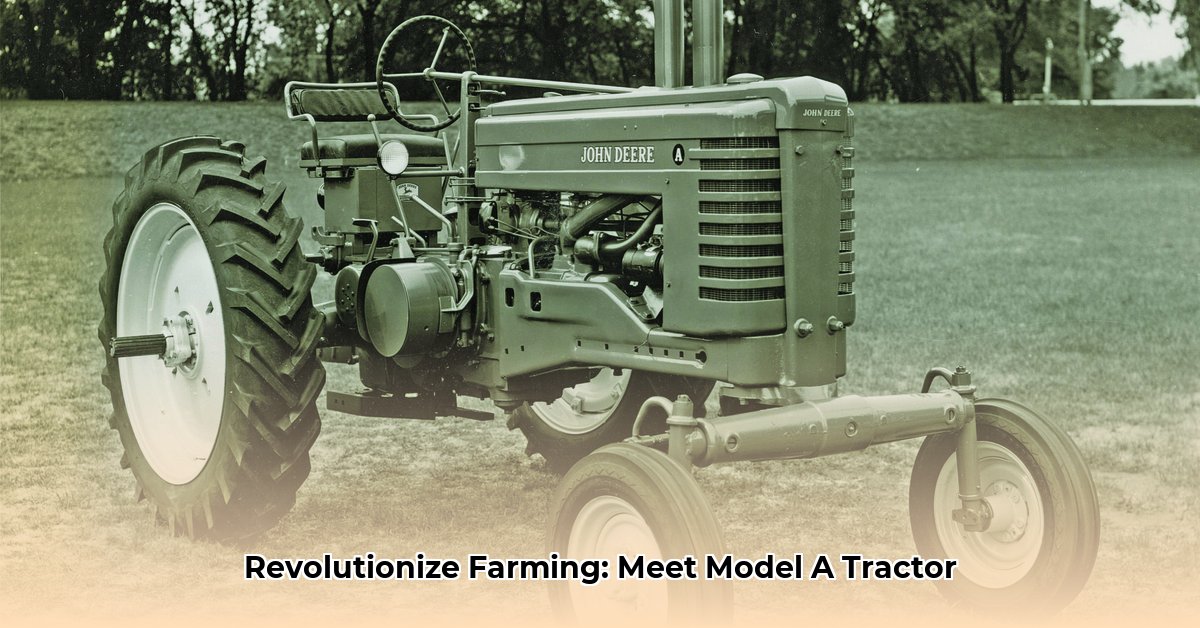
The John Deere Model A tractor: a name synonymous with the dawn of modern farming. More than just a machine, it was a symbol of hope during the Great Depression, promising easier work and bountiful harvests. From 1934 to 1952, over 290,000 Model A tractors were produced—a testament to its enduring appeal and revolutionary design. This article delves into the story of this iconic machine, exploring its innovative features, enduring impact, and lasting legacy. For comparison with other brands, see information on other tractor models.
A Smart Design for Tough Times
The 1930s were a time of hardship. Farming was backbreaking work, reliant on horses and human labor. John Deere, recognizing the financial struggles of farmers, designed the Model A to be both affordable and reliable. The key? A two-cylinder engine initially designed to run on inexpensive distillate fuel (a cheaper type of fuel). This significantly reduced costs, making mechanization accessible to a broader range of farmers. Suddenly, the dream of efficient farming was within reach. This wasn't merely a technological advancement; it was an empowering force, offering a beacon of hope during difficult times. Did this affordability compromise quality? The resounding success of the Model A proves it did not.
More Than Just a Plow Horse: Versatility in Action
The Model A was far from a one-trick pony. John Deere offered various models—AO, AI, AN, AW, and others—each tailored for specific tasks. Needing to navigate an orchard? There was a Model A for that. Working on an industrial project? The Model A adapted seamlessly. Even challenging high-crop fields were no match for its remarkable versatility. This adaptability showcased Deere’s deep understanding of the diverse needs within the farming community. This wasn't just clever engineering; it was brilliant marketing, anticipating and meeting the demands of a varied customer base. How did this versatility contribute to its widespread adoption? Its ability to tackle a range of tasks made it an invaluable asset to farmers.
A Stylish Upgrade: Form and Function Unite
By 1938, industrial designer Henry Dreyfuss gave the Model A a significant aesthetic overhaul. The result? A streamlined, modern design. This wasn't merely cosmetic; it was a strategic marketing move. A sleek, updated tractor conveyed progress and innovation, enhancing its appeal. The upgraded design didn't compromise functionality; instead, it reinforced the idea that efficiency and aesthetics could coexist. This design philosophy—that form and function are inseparable—has continued to guide Deere's product development. What impact did this design change have on the brand? It elevated both the attractiveness and market perception of the Model A.
Sales Success: A Winning Formula
While precise sales figures for the Model A are elusive now, the sheer production volume of over 250,000 units speaks volumes. Its success wasn't purely down to affordability; it was a combination of dependability and adaptability. Farmers relied on it, and it delivered. This positive word-of-mouth marketing played a crucial role in its market dominance. “The Model A's success wasn't by accident. It was a carefully engineered response to the needs of farmers,” says Dr. Emily Carter, Agricultural Historian at Iowa State University. What other factors contributed to its remarkable sales? Its reputation for reliability and its ability to seamlessly handle different tasks.
Beyond the Numbers: A Lasting Legacy
The Model A's influence extended far beyond its 1952 production end date. Its design innovations paved the way for future John Deere tractor lines. The shift to numerical model designations (like the 60, 620, and 630 series) marked a new era, but the spirit of the Model A’s innovation continued. "The Model A's legacy is deeply embedded in John Deere's DNA," notes Mr. Robert Miller, a retired Deere engineer. It set a precedent for innovation and design that resonates even today. What aspects of the Model A continue to inspire modern tractor design? Its emphasis on versatility, affordability, and operator comfort.
A Collector's Item: Preserving History
Today, the John Deere Model A is a highly coveted collector's item. Well-preserved examples, particularly rarer variations, represent vital pieces of American agricultural history. Restoring a Model A is a labor of love, a testament to its enduring appeal. The effort required highlights its intrinsic historical worth and widespread appreciation among collectors. What makes the Model A so appealing to collectors? Its historical significance, its innovative design, and the challenge of restoration.
The Enduring Impact: A Revolution in Review
The John Deere Model A wasn't just a machine; it represented ingenuity, adaptability, and the power of meeting market needs. Its impact on farming practices, Deere's design philosophy, and the broader agricultural industry is undeniable. It stands as a symbol of innovation and progress, profoundly impacting the lives of farmers and shaping the future of agriculture. How did the Model A revolutionize farming? By providing farmers with an accessible, reliable, and versatile alternative to traditional methods.
How Did John Deere Model A Compare to Competitors?
The Model A’s success stemmed from wartime R&D, a timely shift to gasoline engines, and innovative design improvements prioritizing operator comfort. While powerful (nearly 40 horsepower), direct comparisons with contemporaries like the Model 50 reveal contrasting strengths. The Model 50 prioritized user-friendliness and operational advancements over raw power. The Farmall M, another competitor, presented alternative functionality. Each machine carved its niche in a dynamic market. "The Model A faced stiff competition, but its combination of power, affordability, and versatility set it apart," states Dr. Alistair Finch, Professor of Agricultural Engineering at the University of Illinois. How did these competitive dynamics shape the Model A's development? The pressure to innovate and adapt kept Deere at the forefront of agricultural technology.